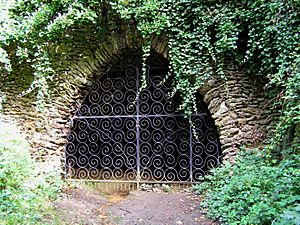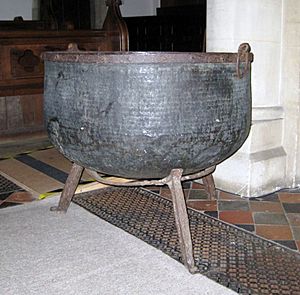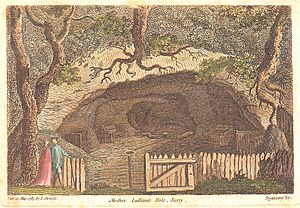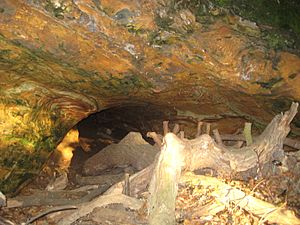Mother Ludlam's Cave facts for kids
Mother Ludlam's Cave is a small cave found in the sandstone cliffs of the River Wey valley. You can find it near Farnham, in Surrey, England. This cave is famous for many local stories and legends.
Inside the cave, there's a spring that has been known for a very long time. In the 1200s, it was called "Ludewell." Monks from Waverley Abbey found this spring in 1218 when their usual water source dried up. They decided to use it for their abbey and named it St Mary's Well. The cave was formed naturally by the spring, but people might have made it bigger over time. It was later decorated to look like a grotto, and an ironstone arch was added to its entrance.
In the past, people explored the cave. In 1945, it was measured to be about 200 feet long. By 1961, it was 192 feet long because part of the roof had fallen in.
Contents
What Does "Ludlam" Mean?
The name "Ludwell" for the spring might come from an old Celtic word. It means "bubbling spring."
Some stories say the name comes from an ancient king named Lud. He was a ruler of Celtic Britain and is even said to have founded London. King Lud supposedly bathed his wounds in the spring after battles. He was also seen as a Celtic god of healing. People believe that Celtic speakers knew about this special spring long ago.
Another idea is that "Ludwell" comes from an old Anglo-Saxon phrase, "hlūd well." This means "a loud, noisy spring," which makes sense for a bubbling spring. The name "Mother Ludlam" keeps the "Lud" part of these old names.
The Legend of Mother Ludlam, the White Witch
Mother Ludlam's Cave is strongly connected to the legend of "Mother Ludlam." She was believed to be a white witch who lived in the cave. The earliest versions of this story, from the 1600s, didn't mention a witch. Instead, they were likely about fairies.
There are a few different versions of the legend:
- The Cauldron Loan: In a simple version, Mother Ludlam would lend out household items. One day, a large cauldron was borrowed but never returned. Mother Ludlam became very angry. The person who borrowed it was so scared that they ran to Frensham Church for safety. The cauldron linked to this story is still in the church today. However, historians think it was actually used long ago for making "church ale" for festivals. It's made of hammered copper and is quite big.
- The Devil's Theft: Another version from 1937 tells of the Devil visiting Mother Ludlam. He was disguised and asked to borrow her cauldron for mixing potions. Mother Ludlam recognized him by his hoof-prints. She refused, so the Devil stole the cauldron. Mother Ludlam chased him. As the Devil made huge leaps, he created a series of hills. These hills are now known as the Devil's Jumps near Churt. The Devil dropped the cauldron on the last hill, called "Kettle Bury." Mother Ludlam got it back and placed it in Frensham Church to keep it safe from the Devil.
- The Fairies' Curse: A version from the 1920s says you could borrow the cauldron from fairies. You had to climb the highest of the Devil's Jumps, called Stony Jump. Then, you would whisper to the fairies through a hole in the rocks. One borrower didn't return the cauldron on time. So, the fairies cursed them, making the cauldron follow them everywhere. Upset by this, the person ran into Frensham Church. They collapsed and died there, leaving the cauldron stuck inside.
William Cobbett's Visit
A writer named William Cobbett wrote about the cave in his book Rural Rides. He visited on October 27, 1825. He described how the cave area had changed since he was a boy.
Cobbett noted that the beautiful features he remembered were gone. The fences, the basins for the stream, and the drinking cups were all missing. The paved path for the stream was now a dirty gutter. The lovely grove of laurels had become a messy alder patch.
Today, the cave is in an even worse condition. Part of its roof collapsed during a very dry period in 1976. This event also covered the cave floor with a large pile of sand.
Wildlife in the Cave
The cave is a home for different kinds of bats. You can find Natterer's Bats, Daubenton's Bats, and Long-eared Bats here. Efforts are being made to encourage Greater Horseshoe Bats to return to the cave.
To protect the bats, a special grille was put at the cave entrance in 2001/2002. This project was a team effort by Waverley Borough Council, English Nature, and Farnham Town Council. There's also a plan for a bat-friendly grille for a hole in the cave roof.
Across from the cave is the Moor Park Nature Reserve. This area is a SSSI because of its important wildlife. It mainly consists of a type of wet woodland called alder carr.
Father Foote's Cave
Above Mother Ludlam's Cave, there is another, smaller cave called Father Foote's Cave. This cave also has a story.
A man named Foote supposedly dug this cave and lived there for a while. He had previously stayed at an inn in Farnham. One day, he was found unwell by the stream. He was taken to the Farnham workhouse, where he died the same day in 1840. His last words were "Take me to the cave again." It's not known how his name changed to "Father" Foote.





